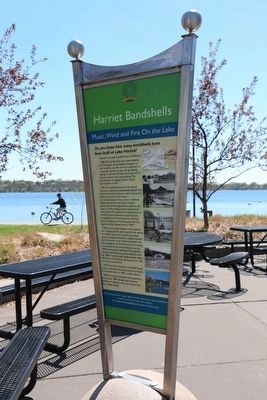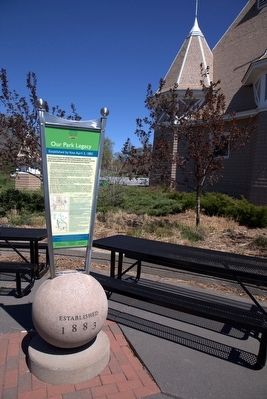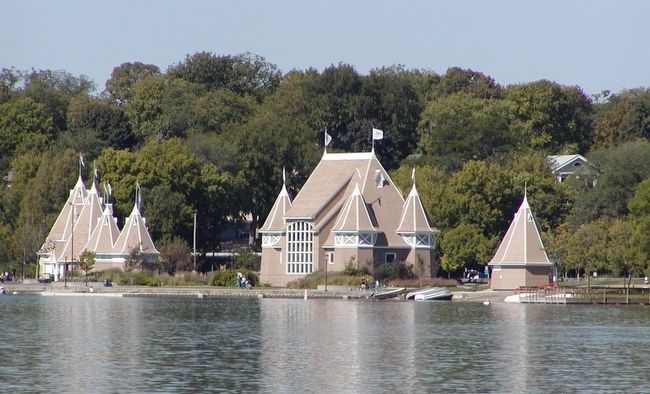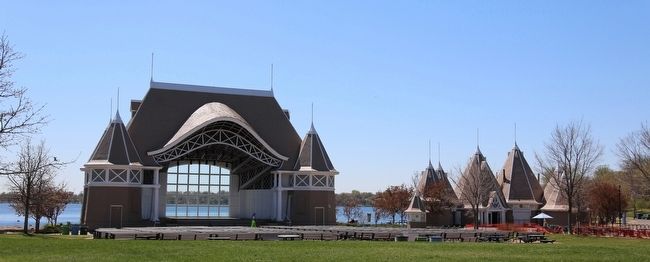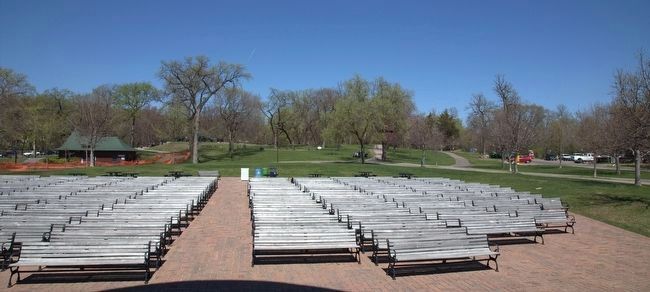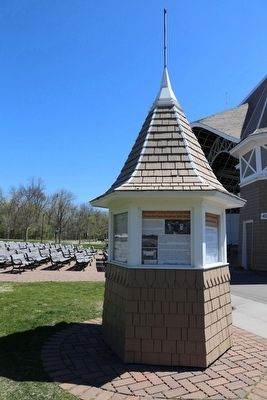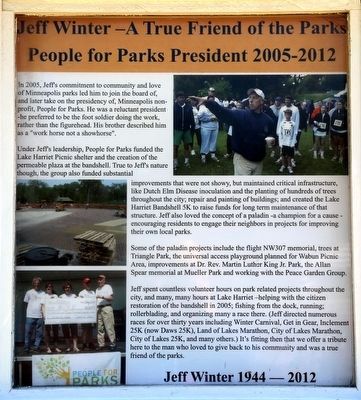Southwest Minneapolis in Hennepin County, Minnesota — The American Midwest (Upper Plains)
Harriet Bandshells / Our Park Legacy
Music, Wind and Fire on the Lake
— Established 1993 —
1888: The first bandshell was constructed by the Minneapolis Street Railway Company on their property near the rail line. It was built to encourage ridership on the rails by drawing tourists to the lake. The lake was at the end of the line, far from most city residents.This bandshell was the largest of them all and burned down in 1891.
1891: The Street Railway built the second structure, a two-story, pagoda-style pavilion. The pavilion had walls of shutters, which allowed the music to float across the water.
To take advantage of this, a series of different floating bandshells were constructed for performers. Boaters gathered to listen on the water. (The Park Board earned revenue from boat rentals.) The pavilion was the first built on the Park Board’s lakeshore property. It was managed by the Street Railway but the Park Board had approval of all entertainment. The pagoda pavilion burned down in 1903.
1904: The third, neo-classical revival, pavilion had a rooftop garden and bandshell with seating for 1,800. A restaurant and bathing facilities were on the ground level.Two wings projected over the water. It was the first bandshell built and managed by the Park Board. Partial funding was donated by the Street Railway from the 1903 fire insurance settlement. They decided not to re-build because profits declined when the 1890s “bicycle craze” began to draw riders off the line.The building was destroyed in 1925 by a severe wind storm.
1927: This small “temporary” bandshell lasted nearly six decades, hosting thousands of events. It was taken down in 1985, to make way for ...
1986: The current bandshell was inspired by the historic 1890s shingle-style restroom building. A refectory and picnic shelter have been added nearby.
Our Park Legacy, established by vote April 3, 1883. “An act providing for the designation, acquisition, laying out and improvement of lands in the City of Minneapolis for a system of public parks and parkways; and for the care and government thereof.”
With the passage of what was then called the Park Act, the people of Minneapolis set in motion the creation of one of the world’s premier municipal park systems. By approving the creation of a Park Board dedicated exclusively to acquiring and maintaining parks—apart from the management of other city interests—the people of Minneapolis placed the highest priority on preserving and maintaining open spaces for all of us to use and enjoy. That priority has been passed on to us, as important as ever.
Highlights of the park system which we can still enjoy today, thanks to the foresight of those long ago:
Public ownership of nearly all waterfront. Almost all lake shores, streambanks and banks of the Mississippi River in the city are owned and managed by the Park Board, and are free to be enjoyed and explored. Park Board ownership allows visitors more than just an access point or two; the city’s waterfront has been preserved for us all.
Well dispersed neighborhood parks. Nearly every home in the city is within a half-mile, or six blocks,
of a park or playground. Parks help us create “a sense of place and a sense of belonging,” as Superintendent Jon Gurban said in 2007.They provide places of recreation and respite for all of us, indoors and out, from crafting in a recreation center, to soaring on a swing, from playing a spirited game of soccer to sitting quietly in a garden, wild or cultivated.
A beautiful, cooling canopy of shade. The Park Board has legal control and authority over trees in parks, but also those along Minneapolis streets—more than 200,000 of them.The Park Board acquired that control in 1885 in order to protect trees from “hungry horses, stray cows and careless [carriage] drivers” in the words of Charles Loring, then President of the Park Board. In the 1880s there were few trees south of Franklin Avenue with the exception of occasional clumps of oaks. The Park Board has been responsible for planting and protecting most of the street trees in the city and continues to plant about 3,500 new trees each year.
25 things you may not know about Minneapolis Parks: (in no specific order)
1. Minneapolis has a higher percentage of its land devoted to parks than any other American city of similar population density.
2. Murphy Square was the first Minneapolis park. It was donated to the city in 1857 by Edward Murphy. and transferred to the Park Board in 1883.
3. The original motto on the seal of the Board of Park Commissioners was, “Health and Beauty,” with an image of Minnehaha Falls in the background.
4. The 1,200 trees on Victory Memorial Drive commemorate Hennepin County lives lost during World War I and were originally all American elms.
5. Lake Harriet was never connected to the Chain of lakes because it is seven feet lower in elevation than Lake Calhoun.
6. The Works Progress Administration (WPA), a federal government program that created jobs to help lift the country out of the Great Depression, built countless features in Minneapolis parks in the 1930s and 40s. The WPA stamp can be found on sidewalks, picnic tables, benches and sandboxes, as well as on bridges and retaining walls along the river and creeks.
7. There are four waterfalls in the city: Minnehaha, St. Anthony, Bridal Veil, and Shingle Creek.
8. The Park Board has had only ten superintendents in 125 years (two acting superintendents served only for about a year.
9. Alter a polio outbreak in Minneapolis in 1946, and another in 1948, group gatherings in parks declined and beaches were deserted. By the time a vaccine became available in 1960, television had taken its hold on leisure time and few park programs achieved the huge crowds of the first half of the century.
10. The Wild Botanic Garden, now named after its creator. Eloise Mier, opened in 1907, was the first public garden to celebrate native plants. Its opposite. the Lyndale Rose Garden, opened in 1908. Both gardens remain relatively unchanged.
11. The land on which the Minneapolis Institute of Arts a built actually is Dorilus Morrison Park. This park was donated to the Board specifically for construction of an art museum, which was built with private funding.
11. A pipeline was constructed in the 1950s from Basset’s Creek to Brownie Lake to reverse declining water levels in the Chain of lakes. Another pipeline was constructed to draw water from the Mississippi River to the Chain of Lakes and also to increase water flowing over Minnehaha Falls. Water pumping ceased in the 1990s.
13. The name “Grand Rounds” was given to Minneapolis’s system of interconnecting parkways by Wiliam Folwell in 1891. Folwell was the first president of the University of Minnesota, and served as a park commissioner from 1889 to 1907.
14. 1n the 1980s, “Elmer the Elm Tree.” a tree mascot, was introduced to teach school children about Dutch elm disease. He was very popular. He was once kidnapped, but was returned, unharmed, unlike the hundreds of thousands of real elms which succumbed to Dutch elm disease.
15. The first playground equipment was added to Minneapolis parks in 1904. It consisted of sandboxes and swings at Loring and Riverside Parks. Logan and Riverside received more extensive “play apparatus” in 1906.
16. In 1990, park staff began control of the first major non-native invasive species in the Chain of Lakes by harvesting Eurasian Water Milfoil. On land, controlling other invasive species like buckthorn is a continual challenge for staff.
17.
The Park Board led the creation of the interagency partnership called the Clean Water Partnership to improve the water quality in the Chain of Lakes watershed in the 1990s.
18.1n 2008 there were 62 free wading pools in Minneapolis parks, one full sized pool, two water parks, and 11 beaches.
19. The Board of Park Commissioners changed its name to the Minneapolis Park and Recreation Board in 1969.
20. The first “active” recreation provided in parks was ice skating on the pond at Loring Park in 1884. The ice was cleared and planed using horse drawn implements.
21. The first baseball field in a park was built in 1908 at The Parade.
22. Minnehaha Park had the first zoo in Minneapolis in the 1890s. Animals included deer, elk bison, sea lions, an alligator, and a mountain lion. The zoo was sold in 1907, but deer and elk were kept in the park until the 1920s.
23. The Park Board developed Wold-Chamberlin field, an airport, not a sports facility, in 1923. The Metropolitan Airports Commission began leasing the land around 1940 and the Lindberg Terminal now sits on it.
24. The golf course at Theodore Wirth Park was the first in Minneapolis. Called Glenwood Park in 1919, the nine-hole course had “greens” made of sand.
25. The first parks purchased by the Board in 1883 were Farview, Logan, Loring, and Riverside.
The Minneapolis Park and Recreation Board Mission: The Minneapolis Park and Recreation Board shall permanently preserve, protect, maintain, improve and enhance its natural resources, parkland and recreational opportunities for current and future generations. The Minneapolis Park and Recreation Board exists to provide places and recreation opportunities for all people to gather, celebrate, contemplate, and engage in activities that promote health, well-being, community, and the environment.
Topics. This historical marker is listed in these topic lists: Entertainment • Environment. A significant historical date for this entry is April 3, 1883.
Location. 44° 55.682′ N, 93° 18.479′ W. Marker is in Minneapolis, Minnesota, in Hennepin County. It is in Southwest Minneapolis. Marker can be reached from the intersection of West Lake Harriet Boulevard and William Berry Parkway and West Lake Harriet Blvd.. Touch for map. Marker is at or near this postal address: 4135 E Lake Harriet Blvd, Minneapolis MN 55419, United States of America. Touch for directions.
Other nearby markers. At least 8 other markers are within 2 miles of this marker, measured as the crow flies. Geology of Minnesota (within shouting distance of this marker); First School House (about 400 feet away, measured in a direct line); Como–Harriet Streetcar Line (about 400 feet away); First Dwelling in Minneapolis (approx. 0.8 miles away); Harriet Bandshells (approx. 0.8 miles away); You Are Here… Lake Calhoun (approx. 1.4 miles away); In Memory of the Boys of Our Navy (approx. 1.4 miles away); Minnesota World War I Marine Corps Memorial (approx. 1.4 miles away). Touch for a list and map of all markers in Minneapolis.
Also see . . . Lake Harriet. Wikipedia entry. “On the walking path near where Queen Avenue tees into the perimeter drive around the lake, there is an ‘elf house’ carved into the base of an ash tree. For several years, one could leave a letter for the elf supposedly living there and find a letter in reply sometime in the next few days. During the winter season, the elf door is shut and a plank appears stating he has ‘moved to his castle in the east.’ It reopens around springtime. Other parkland near the lake includes a picnic ground just north of the bandshell, Lyndale Park, and the Thomas Sadler Roberts bird sanctuary on the northeast corner of the lake. Located adjacent to the bird sanctuary is the tranquil Peace Garden, and across the street is a large garden featuring many varieties of roses. Lakewood Cemetery is located between the southeast corner of Lake Calhoun and the north shoreline of Lake Harriet. Located just 2 blocks West is the quaint shopping district of Linden Hills, often referred to as ‘a small town in the City’.” (Submitted on August 7, 2015, by J. J. Prats of Powell, Ohio.)
Additional commentary.
1. Jeff Winter—A True Friend of the Parks
People for Parks President, 2005-2012.
In 2005, Jeff’s commitment to community and love of Minneapolis parks led him to join the board of, and later take on the presidency of, Minneapolis non-profit, People for Parks. He was a reluctant president—he preferred to be the foot soldier doing the work, rather than the figurehead. His brother described him as a “work horse not a showhorse.”
Under Jeff’s leadership, People for Parks funded the Lake Harriet Picnic shelter and the creation of the permeable plaza at the bandshell. True to Jeff’s nature though, the group also funded substantial improvements that were not showy, but maintained critical infrastructure, like Dutch Elm Disease inoculation and the planting of hundreds of trees throughout the city; repair and painting of buildings; and created the Lake Harriet Bandshell 5K to raise funds for long term maintenance of that structure. Jeff also loved the concept of a paladin—a champion for a cause—encouraging residents to engage their neighbors in projects for improving their own local parks.
Some of the paladin projects include the flight NW307 memorial, trees at Triangle Park, the universal access playground planned for Wabun Picnic Area, improvements at Dr. Rev. Martin Luther King Jr. Park, the Allan Spear memorial at Mueller Park and working with the Peace Garden Group.
Jeff spent countless volunteer hours on park related projects throughout the city, and many, many hours at Lake Harriet—helping with the citizen restoration of the bandshell in 2005; fishing from the dock; running; rollerblading, and organizing many a race there. (Jeff directed numerous races for over thirty years including Winter Carnival, Get in Gear, Inclement 25K (now Daws 25K), Land of Lakes Marathon, City of Lakes Marathon, City of Lakes 25K, and many others.) It’s fitting then that we offer a tribute here to the man who loved to give back to his community and was a true friend of the parks.
Jeff Winter, 1944–2012
— Submitted August 7, 2015.
Credits. This page was last revised on February 12, 2023. It was originally submitted on August 7, 2015, by J. J. Prats of Powell, Ohio. This page has been viewed 638 times since then and 39 times this year. Photos: 1, 2, 3, 4, 5, 6, 7. submitted on August 7, 2015, by J. J. Prats of Powell, Ohio.
Editor’s want-list for this marker. More photos of the bandshell in all seasons • Can you help?
